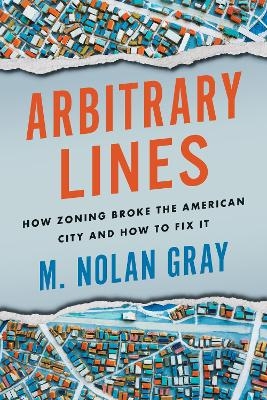
Arbitrary Lines
Island Press (Verlag)
978-1-64283-254-9 (ISBN)
- Lieferbar (Termin unbekannt)
- Versandkostenfrei innerhalb Deutschlands
- Auch auf Rechnung
- Verfügbarkeit in der Filiale vor Ort prüfen
- Artikel merken
What if scrapping one flawed policy could bring US cities closer to addressing debilitating housing shortages, stunted growth and innovation, persistent racial and economic segregation, and car-dependent development?
It’s time for America to move beyond zoning, argues city planner M. Nolan Gray in Arbitrary Lines: How Zoning Broke the American City and How to Fix It. With lively explanations and stories, Gray shows why zoning abolition is a necessary—if not sufficient—condition for building more affordable, vibrant, equitable, and sustainable cities.
The arbitrary lines of zoning maps across the country have come to dictate where Americans may live and work, forcing cities into a pattern of growth that is segregated and sprawling.
The good news is that it doesn’t have to be this way. Reform is in the air, with cities and states across the country
critically re-evaluating zoning. In cities as diverse as Minneapolis, Durham, and Hartford, the key pillars of zoning are under fire, with apartment bans being scrapped, minimum lot sizes dropping, and off-street parking requirements disappearing altogether. Some American cities—including Houston, America’s fourth-largest city—already make land-use planning work without zoning.
In Arbitrary Lines, Gray lays the groundwork for this ambitious cause by clearing up common confusions and myths about how American cities regulate growth and examining the major contemporary critiques of zoning. Gray sets out some of the efforts currently underway to reform zoning and charts how land-use regulation might work in the post-zoning American city.
Despite mounting interest, no single book has pulled these threads together for a popular audience. In Arbitrary Lines, Gray fills this gap by showing how zoning has failed to address even our most basic concerns about urban growth over the past century, and how we can think about a new way of planning a more affordable, prosperous, equitable, and sustainable American city.
M. Nolan Gray is a professional city planner and an expert in urban land-use regulation. He is currently completing a Ph.D. in urban planning at the University of California, Los Angeles. Gray previously worked on the front lines of zoning as a planner in New York City. He now serves as an Affiliated Scholar with the Mercatus Center at George Mason University, where he advises state and local policymakers on land-use policy. Gray is a contributor to Market Urbanism and a widely published author, with work appearing in outlets such as The Atlantic, Bloomberg Citylab, and The Guardian. He lives in Los Angeles, California and is originally from Lexington, Kentucky.
Introduction
Part I
Chapter 1. Where Zoning Comes From
Land Use Before Zoning
What Changed?
1916
The Federal Push
Chapter 2. How Zoning Works
How Zoning Is Born
Decoding the City
Everything in Its Right Place
Don’t Be Dense
How Zoning Changes
Patching Up Zoning?
Part II
Chapter 3. Planning an Affordability Crisis
Zoned Out
Mandating Mansions
Housing Delayed is Housing Denied
Why Did This Happen?
Chapter 4. The Wealth We Lost
How Cities Make Us Rich
Zoning for Stagnation
How Much Poorer Are We?
Chapter 5. Apartheid by Another Name
Zoning for Segregation
All Are Welcome, If You Can Afford It
The Bitter Fruits of Segregation
Chapter 6. Sprawl by Design
Zoning for Sprawl
Assume a Car
Fleeing Sustainability
Part III
Chapter 7. Toward a Less Bad Zoning
The Low-Hanging Fruit of Local Reform
Taming Local Control
Is There a Role for the Federal Government?
Turning Japanese
Chapter 8. The Case for Abolishing Zoning
Why Reform Isn’t Enough
Steelmanning Zoning
Meanwhile, Back in the Real World
Chapter 9. The Great Unzoned City
The Compromise That Saved Houston
How Cities Organize Themselves
Land-Use Regulation After Zoning
How to Abolish Zoning in Two Easy Steps
Chapter 10. Planning After Zoning
It’s the Externalities, Stupid!
Desegregating the Post-Zoning City
Reviving the Plan
Conclusion
Appendix: What Zoning Isn’t
Zoning Isn’t the Market
Zoning Isn’t the Only Kind of Land-Use Regulation
Zoning Isn’t Environmental Regulation
Zoning Isn’t Planning
Acknowledgements
About the Author
Recommended Reading
Endnotes
Index
| Erscheinungsdatum | 27.04.2022 |
|---|---|
| Zusatzinfo | 20 illustrations |
| Verlagsort | Washington |
| Sprache | englisch |
| Maße | 152 x 229 mm |
| Themenwelt | Naturwissenschaften ► Geowissenschaften ► Geografie / Kartografie |
| Technik ► Architektur | |
| ISBN-10 | 1-64283-254-5 / 1642832545 |
| ISBN-13 | 978-1-64283-254-9 / 9781642832549 |
| Zustand | Neuware |
| Haben Sie eine Frage zum Produkt? |
aus dem Bereich


